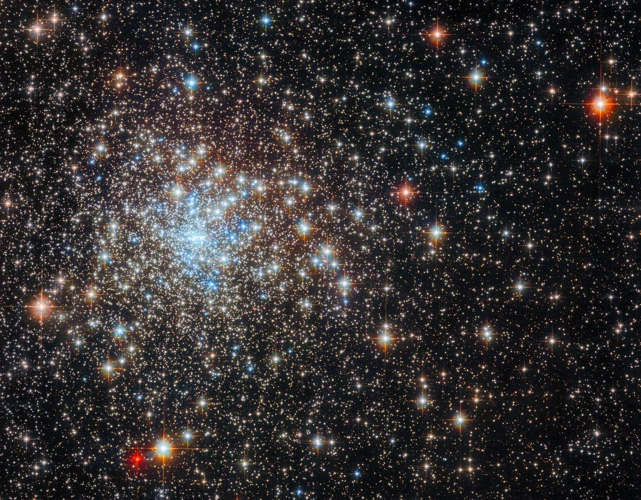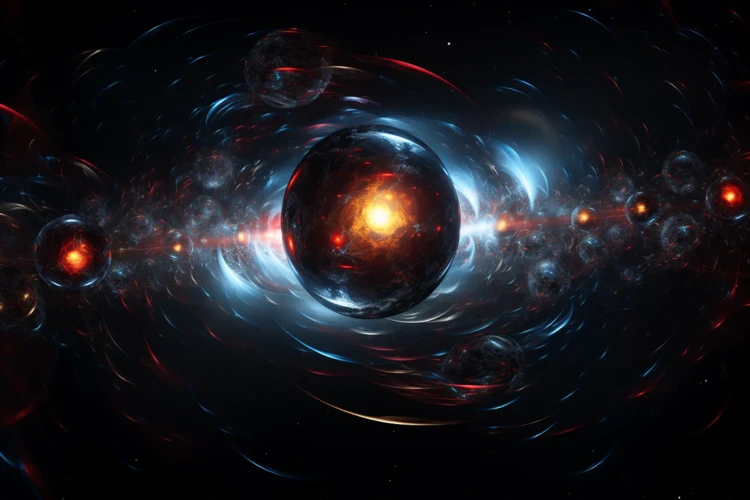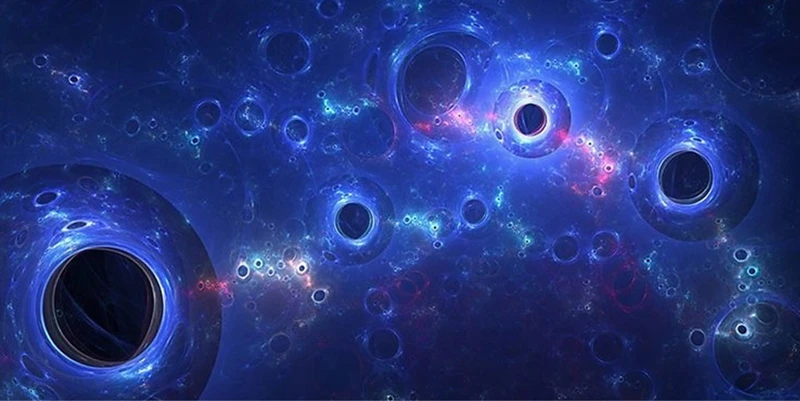The mysterious enigma of dark matter has perplexed scientists for decades. This invisible and elusive substance has left astronomers scratching their heads, as its presence can only be inferred through its gravitational effects on visible matter. Theories and observations have attempted to shed light on this cosmic puzzle, from the missing mass problem to the phenomenon of gravitational lensing. Researchers have embarked on a quest to uncover the nature of dark matter through various particle physics experiments, direct and indirect detection methods, and the search for new particles at colliders. While the composition of dark matter remains a mystery, theories range from cold dark matter models to warm dark matter theories and alternative explanations involving axions and other particles. Its role in the universe is also profound, influencing galactic rotation curves, structure formation, and large-scale clustering. As scientists continue to grapple with the challenges and devise new detection techniques, the ultimate goal is to understand the interactions between dark energy and dark matter. With technological advancements on the horizon, the hope of unraveling the enigmatic nature of dark matter grows stronger.
Contents
- Theories and Observations
- Uncovering Dark Matter
- The Puzzle of Dark Matter Composition
- Dark Matter’s Role in the Universe
- Challenges and Future Perspectives
- Conclusion
-
Frequently Asked Questions
- 1. How do we know dark matter exists?
- 2. What is the missing mass problem?
- 3. How does gravitational lensing provide evidence for dark matter?
- 4. What are particle physics experiments?
- 5. What are direct and indirect detection methods for dark matter?
- 6. What role do colliders play in the search for dark matter?
- 7. What are cold dark matter models?
- 8. What are warm dark matter theories?
- 9. Are there alternative explanations for dark matter?
- 10. How does dark matter influence galactic rotation curves?
- References
-
Frequently Asked Questions
- 1. What is dark matter and why is it called “dark”?
- 2. How do scientists know that dark matter exists if it cannot be directly observed?
- 3. What is the missing mass problem, and how does it relate to dark matter?
- 4. What are gravitational lensing and its significance in the study of dark matter?
- 5. How are particle physics experiments used to uncover dark matter?
- 6. What are the direct and indirect detection methods employed in the search for dark matter?
- 7. How do colliders contribute to the search for new particles and dark matter?
- 8. What are cold dark matter models, and why are they widely accepted?
- 9. How do warm dark matter theories differ from cold dark matter models?
- 10. Can dark matter be explained by other alternative explanations, such as axions?
- References
- Read More
Theories and Observations

Theories and observations have played a crucial role in the quest to understand the enigmatic nature of dark matter. One of the key puzzles that scientists have focused on is the missing mass problem. By carefully analyzing the gravitational effects within galaxies and galaxy clusters, astronomers have found that the visible matter can account for only a fraction of the observed gravitational forces. This discrepancy suggests the existence of additional, unseen matter, which we now refer to as dark matter. Another compelling observation that supports the existence of dark matter is gravitational lensing, where the gravitational pull of massive objects bends the path of light. This phenomenon has provided valuable insights into the distribution of dark matter across the universe. By studying the distorted images of distant galaxies, scientists have been able to map out the gravitational potential of dark matter in various regions of space. Such observations have helped refine our understanding of the distribution and behavior of dark matter on both small and large scales. These intriguing theories and observations continue to fuel the fascination with dark matter and push scientists to delve deeper into its mysteries.
1. The Missing Mass Problem
The missing mass problem is a fundamental issue that arises when the observed gravitational forces within galaxies and galaxy clusters do not align with the amount of visible matter present. Through meticulous observations and calculations, scientists have determined that the visible matter, such as stars, gas, and dust, can only account for a small fraction of the observed gravitational effects. The remaining gravitational force suggests the existence of a significant amount of unseen matter, which we now refer to as dark matter. This missing mass problem has led scientists to question the nature of this invisible substance and its role in shaping the structure and behavior of the universe. Extensive research and observations, including the study of galactic rotation curves and the dynamics of galaxy clusters, have supported the presence of dark matter and highlighted the significance of its gravitational influence on visible matter. The missing mass problem continues to spark curiosity and drives scientists to explore the mysteries of dark matter in order to gain a deeper understanding of the universe we inhabit.
2. Gravitational Lensing
Gravitational lensing is a fascinating phenomenon that has provided valuable insights into the distribution of dark matter in the universe. This phenomenon occurs when the gravitational pull of massive objects, such as galaxies or galaxy clusters, bends the path of light. As a result, distant objects appear distorted or magnified when their light passes through the gravitational field of these massive structures. This distortion can be observed in the form of arcs, rings, or multiple images of the same object. The study of gravitational lensing has allowed scientists to map the distribution and density of dark matter in regions where its direct detection is challenging.
One remarkable example of gravitational lensing is the phenomenon known as strong lensing, where the bending of light creates highly distorted and amplified images of background galaxies. These gravitational lenses act as cosmic magnifying glasses, allowing astronomers to study distant galaxies that would otherwise be too faint to observe. By analyzing the distorted shapes and positions of these lensed images, scientists can infer the presence and distribution of dark matter in the foreground structure.
In addition to strong lensing, weak gravitational lensing has also proven to be a powerful tool for studying dark matter. Weak lensing refers to the subtle distortions in the shapes of background galaxies caused by the gravitational influence of foreground dark matter. By statistically analyzing the coherent patterns of these distortions, astronomers can create maps that reveal the underlying distribution of dark matter in cosmic structures on larger scales.
The study of gravitational lensing has not only provided evidence for the existence of dark matter but also yielded insights into its properties and behavior. By combining gravitational lensing observations with other data, such as galaxy rotation curves and the cosmic microwave background radiation, scientists have been able to develop more comprehensive models of the universe and refine their understanding of the elusive nature of dark matter.
Gravitational lensing has emerged as a powerful tool in the study of dark matter, allowing scientists to indirectly probe its distribution and unravel its mysteries. The ongoing advancements in observational techniques, such as the development of more sophisticated telescopes and surveys, continue to open new horizons in our exploration of dark matter through the remarkable phenomena of gravitational lensing.
Uncovering Dark Matter

Uncovering the elusive nature of dark matter has been a formidable challenge for scientists. To delve into this cosmic enigma, researchers have pursued a range of approaches. Particle physics experiments have been conducted to search for dark matter particles and their interactions. These experiments involve high-energy collisions to probe the properties of hypothetical particles that may constitute dark matter. Additionally, direct and indirect detection methods have been employed to detect the elusive dark matter particles. Direct detection experiments aim to capture the rare interactions between dark matter particles and ordinary matter, while indirect detection methods look for the products of dark matter annihilation or decay, such as high-energy gamma rays or cosmic rays. Another avenue of investigation involves colliders, powerful machines that accelerate particles to high speeds and collide them together. These collisions may produce new particles, including those that could be associated with dark matter. By analyzing the collision data, scientists strive to identify any signatures of dark matter particles. These efforts to uncover the secrets of dark matter continue to push the boundaries of scientific knowledge, as researchers remain committed to unraveling this cosmic puzzle.
1. Particle Physics Experiments
Particle physics experiments serve as crucial tools in the quest to unravel the mysteries of dark matter. Scientists have designed and conducted various experiments to search for elusive particles that could potentially make up dark matter. One prominent experiment in this field is the Large Hadron Collider (LHC), located at CERN. By colliding particles at high energies, the LHC aims to recreate conditions similar to the early universe. Researchers analyze the collision data to look for any signs of new particles that could be candidates for dark matter. Another important experiment is the Cryogenic Dark Matter Search (CDMS), which focuses on detecting weakly interacting massive particles (WIMPs) – one of the leading candidates for dark matter. The CDMS utilizes ultra-sensitive detectors cooled to extremely low temperatures to detect the rare interactions between WIMPs and atomic nuclei. These experiments, among others, provide valuable insights into potential dark matter particles and their properties. While no direct detection of dark matter particles has been made thus far, these ongoing experiments continue to push the boundaries of our knowledge and bring us closer to understanding the enigmatic nature of dark matter.
2. Direct and Indirect Detection Methods
Direct and indirect detection methods have been crucial in the search for evidence of dark matter. Direct detection methods involve trying to observe the interactions between dark matter particles and ordinary matter. Scientists use detectors deep underground to shield them from the background radiation and cosmic rays that could interfere with the measurements. These detectors are designed to identify the rare occasions when a dark matter particle collides with an atomic nucleus, producing small amounts of detectable energy or heat. Indirect detection methods, on the other hand, rely on the detection of the products of dark matter annihilations or decays. By carefully studying the cosmic rays, gamma rays, or neutrinos produced in these processes, scientists can indirectly infer the presence of dark matter. Experiments like the Large Hadron Collider (LHC) and the Alpha Magnetic Spectrometer (AMS-02) have been instrumental in the search for dark matter particles. They aim to produce or capture high-energy particles that could be potential dark matter candidates. While direct and indirect detection methods have provided valuable insights, the search for conclusive evidence of dark matter continues. By pushing the boundaries of detection techniques and studying the cosmos from different perspectives, researchers hope to uncover the elusive nature of dark matter and its role in shaping the universe.
3. Colliders and the Search for New Particles
Colliders have become essential tools in the search for new particles, including those that may shed light on the nature of dark matter. Scientists use these powerful machines to create high-energy collisions between particles, replicating the extreme conditions present in the early universe. In the hunt for dark matter candidates, researchers focus on identifying particles that interact weakly with ordinary matter. One such candidate is the hypothetical WIMP (Weakly Interacting Massive Particle), which could be a crucial building block of dark matter. Colliders, such as the Large Hadron Collider (LHC), allow scientists to accelerate particles to nearly the speed of light and collide them together. These collisions generate a tremendous amount of energy, which may be sufficient to produce new particles, including those that could be the elusive dark matter particles. By carefully studying the debris and energy patterns resulting from these collisions, scientists search for anomalous signals that could indicate the presence of new particles. Although colliders have not yet directly detected dark matter particles, they have successfully set limits on the properties and interactions of hypothetical particles. The ongoing research and technological advancements in collider experiments continue to push the boundaries of our understanding of dark matter and pave the way towards unraveling its enigmatic mysteries.
The Puzzle of Dark Matter Composition

The puzzle of dark matter composition is another perplexing aspect of this cosmic enigma. While scientists have yet to directly detect dark matter particles, several theories have been proposed to explain their nature. One prevailing theory is the existence of cold dark matter models, which suggest that dark matter particles are slow-moving and interact weakly with regular matter. These models have successfully explained the large-scale structure formation of the universe. However, warm dark matter theories propose particles with higher velocities, which would have wiped out small-scale structures. This leads to ongoing debates and investigations to determine which type of dark matter is dominant. Another intriguing possibility is the existence of axions, hypothetical particles that could account for the elusive nature of dark matter. Axions have gained attention due to their potential involvement in solving the strong CP problem in particle physics. While the search for dark matter continues, advancements in detection techniques such as the use of underground laboratories, particle colliders, and sophisticated detectors offer hope for uncovering the true composition of dark matter. Understanding the nature of dark matter composition will not only deepen our knowledge of the universe but also provide insights into the fundamental particles and forces that govern it.
1. Cold Dark Matter Models
Cold dark matter (CDM) models have been widely studied as a possible explanation for the nature of dark matter. According to these models, dark matter is composed of slow-moving, non-interacting particles that clump together under the force of gravity. This clumping behavior is vital for understanding the formation of large-scale structures in the universe, such as galaxies and galaxy clusters. In CDM models, the initial density fluctuations in the early universe are amplified by gravitational interactions, causing regions of slightly higher density to collapse and form the seeds of structure formation. As time progresses, these collapsed regions attract more matter, leading to the assembly of galaxies and cosmic web-like structures. The success of CDM models in explaining the observed large-scale structure of the universe has made them a favored candidate in the search for dark matter particles. However, CDM models do come with their own challenges. For instance, they predict a higher abundance of dwarf galaxies around larger galaxies like the Milky Way, which is not consistent with observations. Scientists continue to refine and test CDM models, seeking a more comprehensive understanding of dark matter and its role in shaping the cosmos.
2. Warm Dark Matter Theories
One intriguing class of theories in the study of dark matter is the concept of warm dark matter. Unlike cold dark matter, which consists of slow-moving particles, warm dark matter is composed of faster-moving particles. These particles, known as WIMPs (Weakly Interacting Massive Particles), have masses ranging from a few times the mass of protons to thousands of times larger. Warm dark matter theories propose that these faster-moving particles would have different effects on the structure formation in the universe compared to their cold counterparts. One consequence of warm dark matter is the suppression of small-scale structures such as dwarf galaxies and subhalos within larger galaxies. This suppression is believed to be due to the particles’ higher velocities, which would wash out small-scale density fluctuations. The study of warm dark matter has become increasingly relevant in recent years, as observations from galaxy surveys and simulations have provided some evidence for the suppression of small-scale structures. However, it is important to note that warm dark matter is still a subject of ongoing research and debate, as some observations are also consistent with the predictions of cold dark matter models. Understanding the nature of dark matter and whether it is warm or cold remains a fascinating area of exploration in the field of cosmology.
3. Axions and Other Alternative Explanations
Axions and other alternative explanations have emerged as intriguing possibilities in the search for understanding the composition of dark matter. Axions, in particular, have gained attention due to their potential to solve the longstanding puzzles surrounding dark matter. These hypothetical particles, originally introduced as a solution to the strong CP problem in particle physics, could also serve as excellent dark matter candidates. Axions are incredibly light and interact weakly with ordinary matter, making them difficult to detect directly. However, scientists have proposed various experimental techniques to search for axions, such as using strong magnetic fields to convert axions into detectable photons. Additionally, other alternative explanations to traditional dark matter models have been proposed. These include self-interacting dark matter, primordial black holes, and sterile neutrinos, among others. Each of these alternative explanations offers unique possibilities for understanding the enigmatic nature of dark matter. Exploring these alternative theories and conducting experimental tests will provide valuable insights into the true nature of dark matter and its role in shaping the universe.
Dark Matter’s Role in the Universe

Dark matter’s role in the universe is both profound and far-reaching. One of the key phenomena that dark matter influences is the rotation curves of galaxies. Observations have shown that the stars and gas at the outskirts of galaxies are moving much faster than expected based on the visible matter alone. This suggests that there must be an additional gravitational force at play, provided by the unseen dark matter. This gravitational pull helps to hold galaxies together and prevent them from flying apart. Additionally, dark matter plays a significant role in structure formation and large-scale clustering. Through its gravitational interactions, it acts as the scaffolding upon which galaxies and galaxy clusters form. Over time, dark matter’s gravitational pull draws in ordinary matter, leading to the formation of stars, galaxies, and even galaxy clusters. This process of structure formation is a crucial component of the evolution of the universe. By understanding dark matter’s role in these processes, scientists can gain deeper insights into the formation and evolution of cosmic structures. The exploration of dark matter’s influence on the universe continues to be a fascinating topic in astrophysics and cosmology, providing new perspectives on the nature of our cosmic home.
1. Galactic Rotation Curves
Galactic rotation curves provide crucial evidence for the existence of dark matter. When astronomers observe the motion of stars and gas within galaxies, they find that the rotational speed does not decrease with distance from the galactic center, as expected based on the distribution of visible matter. Instead, the rotational velocity remains relatively constant or even increases with increasing distance. This phenomenon goes against the predictions of classical Newtonian physics and implies the presence of additional mass beyond what is accounted for by the visible matter. Dark matter provides a plausible explanation for this discrepancy. It is thought to be distributed more uniformly throughout the galaxy and exerts a gravitational pull that keeps the outer regions revolving at higher speeds. Without the presence of dark matter, the observed galactic rotation curves would be impossible to explain. By studying these rotation curves, scientists have gathered valuable insights into the distribution and properties of dark matter within galaxies. This has led to further investigations into the nature and composition of dark matter, as well as its role in shaping the large-scale structure of the universe. To delve deeper into the mysteries of dark matter, researchers continue to study the dynamics of galactic rotation curves and refine our understanding of its implications.
2. Structure Formation and Large-Scale Clustering
Structure formation and large-scale clustering are fundamental processes influenced by the presence of dark matter in the universe. Dark matter’s gravitational pull plays a crucial role in shaping the cosmic web of galaxies and galaxy clusters that we observe today. Through computer simulations and observations, scientists have been able to study the intricate interplay between dark matter and visible matter. According to the prevailing cosmological model, known as Lambda-CDM, dark matter initially formed tiny fluctuations in the early universe. Over time, these fluctuations grew due to gravity, eventually leading to the formation of cosmic structures such as galaxy clusters and superclusters. The distribution of dark matter, with its dense regions and voids, acts as a scaffolding for the formation of galaxies and galaxy groups. Large-scale clustering refers to the tendency of galaxies and galaxy clusters to cluster together in specific patterns. The cosmic web, composed of filaments and walls of dark matter, serves as a guide for the gravitational collapse of gas and the formation of galaxies along these structures. This interconnected network of dark matter influences the way galaxies move and evolve within it, shaping the cosmic landscape we observe today. Understanding the intricate processes of structure formation and large-scale clustering is crucial for unraveling the nature and role of dark matter in the universe’s tapestry of cosmic evolution.
Challenges and Future Perspectives

Challenges and future perspectives in the study of dark matter lie ahead as scientists strive to unravel its mysteries. One of the major challenges is understanding the potential interactions between dark energy and dark matter. Both of these phenomena are thought to dominate the composition of the universe, but their relationship is still not well understood. Exploring the nature of this interaction is crucial to gaining a deeper understanding of the fundamental forces shaping our cosmos. Technological advancements in detection techniques also pose as an exciting avenue for future research. Improved detectors and observational tools offer the prospect of uncovering new clues about dark matter. For example, the development of advanced detectors like the Axion Dark Matter eXperiment (ADMX) has the potential to detect axions, a hypothetical particle that could be a candidate for dark matter. These advancements in detection technology hold promise in shedding light on the elusive nature of dark matter and bringing us closer to solving this cosmic enigma. As scientists continue to grapple with these challenges, the future perspectives in the study of dark matter remain full of excitement and intrigue.
1. Understanding Dark Energy and Dark Matter Interactions
Understanding the interactions between dark energy and dark matter is a critical step in unraveling the enigmatic nature of the universe. Dark energy, believed to be responsible for the accelerating expansion of the universe, and dark matter, with its gravitational influence, are thought to coexist and interact in fascinating ways. While dark matter is abundant and its gravitational effects are observable, dark energy remains elusive, making their interactions challenging to study. The exploration of this intricate relationship involves theoretical models, simulations, and observations of large-scale structures in the universe. Scientists aim to determine how dark energy and dark matter influence each other’s behavior, whether through the expansion of the universe or the formation of galaxies and galaxy clusters. By uncovering these interactions, researchers can gain deeper insights into the fundamental nature of dark energy and dark matter, providing a more comprehensive understanding of the cosmos as a whole.
2. Technological Advancements in Detection Techniques
Technological advancements in detection techniques have revolutionized the search for dark matter. Scientists are constantly pushing the boundaries of instrumentation and experimental techniques to improve their chances of detecting elusive dark matter particles. One such advancement is the use of underground laboratories to shield experiments from cosmic rays and other sources of background noise. These laboratories provide a controlled environment where sensitive detectors can be operated with minimal interference. Additionally, developments in large-scale particle detectors have allowed researchers to increase the sensitivity of their experiments. For example, experiments like the XENON1T and LUX-ZEPLIN aim to detect dark matter particles through their interaction with ordinary matter. These detectors are filled with liquid xenon and surrounded by sophisticated sensors that can pick up even the tiniest signals resulting from a potential collision between dark matter and xenon atoms. Advancements in astrophysical observatories, such as space-based telescopes and high-resolution imaging techniques, have allowed scientists to indirectly observe the effects of dark matter on galactic structures and large-scale gravitational dynamics. These observations provide valuable insights into the nature of dark matter and its role in shaping the universe. As technology continues to advance, new detection techniques, such as directional detectors that can determine both the energy and direction of dark matter particles, are being explored. These advancements bring us closer to unraveling the mysteries surrounding dark matter and shedding light on its composition and interactions.
Conclusion

In conclusion, the enigmatic nature of dark matter continues to captivate the curiosity of scientists and astronomers alike. Theories and observations have shed light on the missing mass problem and the phenomenon of gravitational lensing, providing valuable insights into the existence and distribution of dark matter. Particle physics experiments, direct and indirect detection methods, and the search for new particles at colliders have pushed the boundaries of our understanding, yet the composition of dark matter remains elusive. Cold dark matter models, warm dark matter theories, and alternative explanations involving axions and other particles offer potential avenues for exploration. Dark matter’s role in the universe is profound, impacting galactic rotation curves, structure formation, and large-scale clustering. As we grapple with challenges such as understanding dark energy and dark matter interactions and advancing detection techniques, the hope of unraveling the mysteries of dark matter grows stronger. The future holds promise for technological advancements that may unlock the secrets of this cosmic puzzle. The journey to comprehend the depths of dark matter beckons, inviting us to delve deeper into the mysteries of the universe.
Frequently Asked Questions

1. How do we know dark matter exists?
Scientists infer the existence of dark matter through its gravitational effects on visible matter. Observations of galactic rotation curves and gravitational lensing support the presence of unseen mass, suggesting the existence of dark matter.
2. What is the missing mass problem?
The missing mass problem refers to the discrepancy between the observed gravitational forces within galaxies and the amount of visible matter present. This indicates the presence of additional, unseen matter, which we call dark matter.
3. How does gravitational lensing provide evidence for dark matter?
Gravitational lensing occurs when the gravitational pull of massive objects bends the path of light. By studying the distorted images of distant galaxies, scientists can map out the distribution of dark matter in different regions of space, providing evidence for its existence.
4. What are particle physics experiments?
Particle physics experiments involve studying the behavior of subatomic particles to gain insights into the nature of dark matter. These experiments aim to detect dark matter particles or uncover other phenomena that can help unravel the mysteries of dark matter.
5. What are direct and indirect detection methods for dark matter?
Direct detection methods involve searching for interactions between dark matter particles and ordinary matter. Indirect detection methods, on the other hand, look for the products or signatures of dark matter annihilation or decay, such as high-energy particles or gamma rays.
6. What role do colliders play in the search for dark matter?
Colliders, such as the Large Hadron Collider (LHC), accelerate particles to high energies and collide them together. These collisions can recreate conditions similar to the early universe and potentially produce new particles, including those that may constitute dark matter.
7. What are cold dark matter models?
Cold dark matter models propose that dark matter consists of slow-moving particles that formed early in the universe. These models successfully explain large-scale structure formation but face challenges on smaller scales, such as the missing satellites problem.
8. What are warm dark matter theories?
Warm dark matter theories suggest that dark matter consists of particles that are lighter and faster-moving compared to cold dark matter particles. These theories aim to address some of the small-scale issues faced by cold dark matter models.
9. Are there alternative explanations for dark matter?
Yes, alternative explanations for dark matter include theories involving axions, hypothetical particles that are extremely light and interact weakly with ordinary matter. Other possibilities include the existence of additional dimensions or modifications to the laws of gravity at large scales.
10. How does dark matter influence galactic rotation curves?
Galactic rotation curves describe the rotation speeds of stars and gas in a galaxy. Dark matter’s gravitational pull is needed to explain the observed flatness of rotation curves, as without it, stars would have insufficient mass to maintain their observed velocities.
References
Frequently Asked Questions

1. What is dark matter and why is it called “dark”?
Dark matter is a mysterious form of matter that does not emit, absorb, or reflect light, making it invisible and undetectable through electromagnetic radiation. It is called “dark” because it does not interact with light in any way.
2. How do scientists know that dark matter exists if it cannot be directly observed?
Scientists have inferred the existence of dark matter through its gravitational effects on visible matter and its impact on the large-scale structure of the universe. Various observations, such as galactic rotation curves and gravitational lensing, provide strong evidence for the presence of dark matter.
3. What is the missing mass problem, and how does it relate to dark matter?
The missing mass problem refers to the fact that the amount of visible matter in the universe cannot account for the observed gravitational forces holding galaxies and galaxy clusters together. Dark matter provides the missing mass and gravitational pull necessary to explain these observations.
4. What are gravitational lensing and its significance in the study of dark matter?
Gravitational lensing is the bending of light by the gravitational pull of massive objects, such as galaxies. By studying the distortions caused by gravitational lensing, scientists can indirectly map the distribution of dark matter in the universe and gain insights into its nature.
5. How are particle physics experiments used to uncover dark matter?
Particle physics experiments, such as those conducted at the Large Hadron Collider (LHC), aim to directly detect and study new particles that may compose dark matter. By colliding particles at high energies, scientists hope to produce dark matter particles and observe their interactions.
6. What are the direct and indirect detection methods employed in the search for dark matter?
Direct detection methods involve searching for the rare interactions between dark matter particles and ordinary matter in highly sensitive detectors located deep underground. Indirect detection methods, on the other hand, look for the products of dark matter annihilation or decay, such as gamma rays or cosmic rays.
7. How do colliders contribute to the search for new particles and dark matter?
Colliders, like the LHC, create conditions similar to those just after the Big Bang. By smashing particles together at high energies, scientists hope to recreate the conditions that may have produced dark matter particles. Studying the collisions may provide clues about the properties and interactions of dark matter.
8. What are cold dark matter models, and why are they widely accepted?
Cold dark matter (CDM) models propose that dark matter consists of slow-moving particles that formed shortly after the Big Bang. These models successfully explain the observed large-scale structure of the universe, including the clustering of galaxies, and are in agreement with several cosmological observations.
9. How do warm dark matter theories differ from cold dark matter models?
Warm dark matter (WDM) theories suggest that dark matter particles have higher velocities than those in cold dark matter models. This additional motion affects the formation of small-scale structures and may explain certain discrepancies between observations and CDM predictions.
10. Can dark matter be explained by other alternative explanations, such as axions?
Axions are hypothetical particles that have been proposed as potential candidates for dark matter. While axions are still being actively studied and researched, they represent one of the alternative explanations for dark matter, offering a different perspective on the enigmatic nature of this cosmic puzzle.







